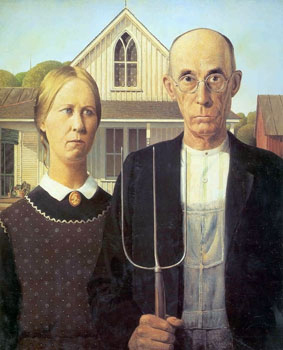
The Cedar Rapids Downtown District has announced the Iowa’s state historical society has certified the Grant Wood Cultural District and a dedication ceremony is set for July 12. Officials say the district is a walkable, mixed-use area that includes many cultural and historical facilities.
It includes the Cedar Rapids Museum of Art, as well as a theater and library.
Wood died in 1942 at age 50. He was born in Anamosa and spent his childhood there before moving to Cedar Rapids.
Wood founded the Stone City Art Colony to help artists through the Great Depression, and in 1934 became a professor of art at the University of Iowa.
Copyright 2010 Associated Press. All rights reserved. This material may not be published, broadcast, rewritten, or redistributed.
AP-CS-06-12-10 1310EDT
* Fair use rationale in American Gothic:
1. This is a significant work that could not be conveyed in words. 2. There is no alternative, public domain or free-copyrighted replacement available. 3. Inclusion is for information, education and analysis only. 4. Its inclusion in the article(s) adds significantly to the article(s) because it shows the subject, or the work of the subject, of the article(s). 5. The image is a low resolution copy of the original work of such low quality that it would be unlikely to impact sales of the work.
* Fair use rationale in Art Institute of Chicago:
1. This is a significant work that could not be conveyed in words. 2. There is no alternative, public domain or free-copyrighted replacement available. 3. Inclusion is for information, education and analysis only. 4. Its inclusion in the article(s) adds significantly to the article(s) because it shows the subject, or the work of the subject, of the article(s). 5. The image is a low resolution copy of the original work of such low quality that it would be unlikely to impact sales of the work.
* Fair use rationale in American Gothic House:
1. This is a significant work that could not be conveyed in words. 2. There is no alternative, public domain or free-copyrighted replacement available. 3. Inclusion is for information, education and analysis only. 4. Its inclusion in the article(s) adds significantly to the article(s) because it shows the subject, or the work of the subject, of the article(s).
* Fair use rationale in American scene painting:
1. This is a significant work that could not be conveyed in words. 2. There is no alternative, public domain or free-copyrighted replacement available. 3. Inclusion is for information, education and analysis only. 4. Its inclusion in the article(s) adds significantly to the article(s) because it shows the subject, or the work of the subject, of the article(s). 5. The image is a low resolution copy of the original work of such low quality that it would be unlikely to impact sales of the work.
* Fair use rationale in Grant Wood:
1. This is a significant work that could not be conveyed in words. 2. There is no alternative, public domain or free-copyrighted replacement available. 3. Inclusion is for information, education and analysis only. 4. Its inclusion in the article(s) adds significantly to the article(s) because it shows the subject, or the work of the subject, of the article(s). 5. The image is a low resolution copy of the original work of such low quality that it would be unlikely to impact sales of the work.
* Fair use rationale in History of painting:
1. This is a significant work that could not be conveyed in words. 2. There is no alternative, public domain or free-copyrighted replacement available. 3. Inclusion is for information, education and analysis only. 4. Its inclusion in the article(s) adds significantly to the article(s) because it shows the subject, or the work of the subject, of the article(s). 5. The image is a low resolution copy of the original work of such low quality that it would be unlikely to impact sales of the work.
* Fair use rationale in Visual arts of the United States:
1. This is a significant work that could not be conveyed in words. 2. There is no alternative, public domain or free-copyrighted replacement available. 3. Inclusion is for information, education and analysis only. 4. Its inclusion in the article(s) adds significantly to the article(s) because it shows the subject, or the work of the subject, of the article(s). 5. The image is a low resolution copy of the original work of such low quality that it would be unlikely to impact sales of the work.
* Fair use rationale in Western painting:
1. This is a significant work that could not be conveyed in words. 2. There is no alternative, public domain or free-copyrighted replacement available. 3. Inclusion is for information, education and analysis only. 4. Its inclusion in the article(s) adds significantly to the article(s) because it shows the subject, or the work of the subject, of the article(s). 5. The image is a low resolution copy of the original work of such low quality that it would be unlikely to impact sales of the work.
Fair Use Rationale in 20th century Western painting:
1. The image is low resolution and unsuitable for commercial purposes. 2. It is representative of the work of Grant Wood, a subject of the article. 3. Its use enhances the reader’s understanding of the topic. 4. No free-use equivalent is available or can be made.

